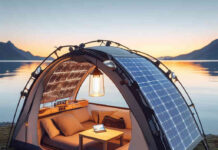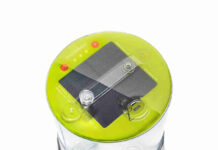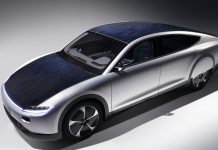
Most technologies for harnessing the sun’s energy capture the light itself, which is turned into electricity using photovoltaic materials. Others use the sun’s thermal energy, usually concentrating the sunlight with mirrors to generate enough heat to boil water and turn a generating turbine. A third, less common approach is to use the sun’s heat — also concentrated by mirrors — to generate electricity directly, using solid-state devices called thermophotovoltaics, which have their roots at MIT dating back to the 1950s.
Now, researchers at MIT have found a way to use thermophotovoltaic devices without mirrors to concentrate the sunlight, potentially making the system much simpler and less expensive. The key is to prevent the heat from escaping the thermoelectric material, something the MIT team achieved by using a photonic crystal: essentially, an array of precisely spaced microscopic holes in a top layer of the material.
The approach mimics Earth’s greenhouse effect: Infrared radiation from the sun can enter the chip through the holes on the surface, but the reflected rays are blocked when they try to escape. This blockage is achieved by a precisely designed geometry that only allows rays that fall within a very tiny range of angles to escape, while the rest stay in the material and heat it up.
Bermel explains that if you put an ordinary, dark-colored, light- and heat-absorbing material in direct sunlight, “it can’t get much hotter than boiling water,” because the object will reradiate heat almost as fast as it absorbs it. But to generate power efficiently, you need much higher temperatures than that. By concentrating sunlight with parabolic mirrors or a large array of flat mirrors, it’s possible to get much higher temperatures — but at the expense of a much larger and more complex system.
“What I’m looking at is an alternative to that paradigm,” Bermel says, by “concentrating the sunlight thermally”: capturing it and reflecting it back into the material. The result, is that the device can absorb as much heat as a standard black object, but “in practice, we can get it extremely hot, and not reradiate much of that heat.” Such a system, “at large scale, is efficient enough to compete with more conventional forms of power. This is an alternative to concentrators.”
In addition, the system is simple to manufacture using standard chip-fabrication technology. By contrast, the mirrors used for traditional concentrating systems, require “extremely good optics, which are expensive.”
The next step in the research, Bermel says, is to test different materials in this configuration to find those that produce power most efficiently. With existing solar thermophotovoltaic systems, “the highest efficiency [in converting sunlight to electricity] is 10 percent, but with this angular-selective approach, maybe it could be 35 to 36 percent.” That, in turn, is higher than the theoretical maximum that could ever be achieved by traditional photovoltaic solar cells.
In the solar-cell business, Bermel points out, “even small differences of 1 percent or so are considered important.” At this point, however, his research has been “mainly theory,” so the next step is building and testing more actual devices. So far, he says, “we have some preliminary results” that validate the theory.



